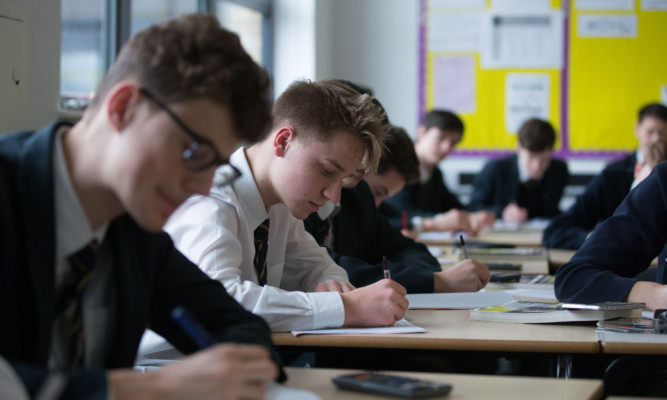Scottish pupils could pass this year’s new Higher Maths exam after answering just 34% of the paper correctly.
The Scottish Qualifications Authority admitted the paper had been “more demanding than intended” and had been forced to adjust the grade boundary downwards.
The Courier revealed last week that nearly one in four Higher exams last year could be passed at C grade even if the candidate answered more than half the paper incorrectly.
Grade boundaries are adjusted downwards or upwards if it is believed the exam was too difficult or too easy.
There were widespread complaints from pupils about the difficulty of this year’s new Higher maths exam.
As a response, the SQA lowered the pass threshold to 44 – or just 33.8% – of the 130 marks available.
A B grade could be obtained with just 61 marks, 46.7% of the available total.
By comparison the new Classical Studies Higher was deemed so easy pupils had to get 57 marks out of 90 – 63% of the total – just to earn a grade C.
In total, 21 of the 48 new Highers had their passing boundaries shifted downwards while 14 were pushed upwards.
Of the 65 old Highers, 20 boundaries – nearly one in three – were lowered while they were raised to above 50% for just three subjects.
Dr Janet Brown, SQA’s chief executive and Scotland’s chief examining officer, said: “As in every year, we carry out a review of assessments to ensure candidates have been able to display their skills, knowledge and understanding.
“If required, grade boundaries are adjusted to take account of any assessments that were easier or more demanding than intended to ensure all candidates received the grades they deserved.”
Almost 143,000 students received their exam results yesterday after sitting the new Highers for the first year and National 4 and 5 qualifications for the second year.
The new qualifications were brought in as part of the Curriculum for Excellence reforms.
A total of 10,854 pupils sat the existing Higher maths while 10,220 sat the new Higher maths.
The attainment rates were 73.1% and 70.8% respectively, similar to that of previous years.
SQA figures show that there were a record 156,000 Higher passes this year, up 5.5% on 2014.
Overall, a total of 107,295 pupils sat the new Highers, with a pass rate of 79.2%.
A further 92,555 pupils sat the existing Highers, recording a pass rate of 76.7%, slightly down on the 2014 pass rate of 77.1%.
Education Secretary Angela Constance said: “Despite concerns about the new Higher Maths exam, it’s clear that the system worked, that candidates have been treated fairly and that standards have been maintained.”
Scottish Labour education spokesman Iain Gray said: “It’s true that pass marks are adjusted each year, but it’s extraordinary to see this drop to just 33.8%. The Highers are the gold standard of Scottish education and this is a big concern.
“The SNP has spent the last few days crowing that there was no problem with the maths exam only for their own exams authority to say today that it was too hard.
“Pupils sitting the Higher maths exam next year shouldn’t have to go through what young people did last May. We need a full review by the SNP Government into the problems with the new Higher maths exam.”
Scottish Conservative young people spokeswoman Liz Smith said: “While it is important to congratulate all those pupils and teachers who have worked so hard to obtain their results, the Scottish Government must not lose sight of the fact that there is still a significant attainment gap between pupils from poorer and wealthier backgrounds.”
